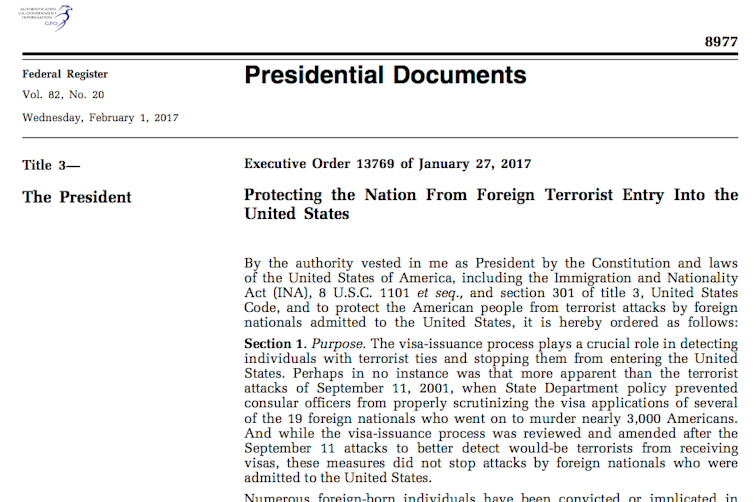
When Donald Trump was campaigning to become the U.S. president, much of the discussion about his growing popularity focused on so-called “angry white males,” who had been struggling through years of declining economic opportunities. Their frustration led some of them to adopt and espouse white supremacist ideology.
In many media portrayals, these men, their anger and their sometimes extreme views on how to return to economic and political relevance were treated as a new phenomenon.
But as a scholar of demography and civil war, I can say definitively that none of this is actually new. Declining opportunities for white males and racist ideology have long been features of U.S. politics, from at least the 1930s until now.
So, the real question is, why are we seeing an upsurge of white nativism among white males now – a nativism which combines anger over lost status with a historically bankrupt white supremacist ideology?
Lagging whites, growing minorities
According to the U.S. Census Bureau’s data, all racial and ethnic minorities are growing faster than whites. Interestingly, one of the fastest growing groups in this country is “mixed race” (full disclosure: my children are such, being both Mexican- and Irish-American).
Still, at 198 million, non-Hispanic whites remained the largest group of Americans in 2014; followed by Hispanics at 55.4 million, and blacks or African-Americans at 42 million. Those who identified with two or more races stood at just under 8 million.
The Census Bureau projects the crossover point at which the non-Hispanic white population will no longer be a majority will occur in 2044. In fact, no one group will comprise a majority. We will become a plural nation of different ethnic and racial groups.
Demography and democracy
That powerful shift in the makeup of the U.S. population has created ideal conditions for a political backlash against people of color, including Hispanics, blacks, Asians and especially immigrants of color.
One prominent example: President Trump’s lament that the U.S. was being overwhelmed by immigrants from “s-hole countries,” rather than from places like Norway.
The backlash also extends to the political leaders who support minorities’ right to be accepted and respected as Americans.
These communities of color remain in the minority. But already in some states, white voters as distinct from all whites are in the minority, and nationally, whites are unlikely to remain in the majority for long.
In California, for example, non-white populations now make up 62 percent of the population, with Hispanic and white populations at near parity at 38 percent each.
Texas, New Mexico and Arizona are among three southern states where the gap between Hispanic minorities and white majorities is closing. Like Florida, these are also states with difficult-to-seal borders and with well-established immigrant communities.
Politics and population shifts
For two decades, I have been studying how population shifts across nation-states have led to their collapse. In some cases, those collapses have been violent, such as in Lebanon in the 1970s and the Soviet Union in the 1990s.
Now, demographic dynamics we previously witnessed in “other” or “developing” states are happening in the U.S.
In places where white people have been a demographic majority, white nativism – characterized by the longing for a period when whites were dominant political and economically – arises when some of the majority white population fears for the loss of its stature relative to non-white populations. And in the U.S., non-whites have higher birth rates and make up the bulk of new immigrants.
As populations shift in democracies, the key question is which group challenges these changes, when – and how? Is it the expanding minority or the declining majority? Is it a combination of fear and desire for change emanating from both the declining majority and rising minority?
Fighting for lost dominance
My research reveals that it is the declining majority that tends to act aggressively, often imagining it must preempt a rising minority. Simply put, declining majorities don’t want to yield their status or hegemony.
This turns demographic shifts into a struggle about power and dominance, with elements of the majority refusing to cede ground to emergent new pluralities and majorities that might displace them.

Government Publishing Office
The result, historically, follows a general pattern: The declining majority resorts to various forms of apartheid, including changes to voting laws, voter suppression and new restrictions on immigrants, and requirements for citizenship.
Examples include Israel’s successive moves to tighten the definition of who is a Jew; Britain’s 2016 referendum on membership in the European Union (for working-class Brits, the immigrants of “color” were Pakistanis and Poles); and the new U.S. ban on immigrants from seven predominately Muslim countries.
Only rarely do a declining majority’s efforts to maintain dominance escalate to violence or state collapse, as was the case with the Soviet Union.
From demographic to political decline
Mirroring the decline in fortunes of the “angry white male” who supported President Trump is the declining fortunes of the Republican Party.
The current U.S. president leads a minority political party whose membership has been in decline for over two decades.
President Trump lost the general election by over 3 million votes. The number of U.S. citizens of voting age who identify as Republicans has dropped steadily since 1994, compared to those who identify as Democrat or Independent.
The GOP has managed its decline in exactly the same way a declining white majority population might have done: It has resorted to extreme gerrymandering, voter suppression, calls for limits on immigration, and now citizenship restrictions.
The president’s angry rhetoric has arguably been responsible for fomenting a rise in overt bigotry, and in rare but an increasing number of cases, violence against non-white immigrants, and ethnic, religious, disabled and LGBTQ minorities. In one documented case, a 56 year-old Trump supporter named Cesar Sayoc mailed a series of bombs to “Trump critics.” His van, in which he had apparently been living, was covered with often violent imagery directed against people of color and political opponents of President Trump, including a sticker featuring then-Representative Nancy Pelosi with rifle-scope crosshairs superimposed.
The partisan divide is further fueled by the conflict over whether non-white immigration is a threat to U.S. security and prosperity.
Immigration to the U.S. has been fairly constant since 1990.
What has changed is the number of refugees fleeing civil wars in Afghanistan, Iraq, Somalia and Syria who are coming to the U.S. According to the United Nations Refugee Agency, there are 65.6 million forcibly displaced people in the world – a population greater than that of the U.K. – of which about one-third, 25.4 million, are refugees.
The numbers of refugees and asylum-seekers has been increasing since 2013. At the end of 2013, the U.S. hosted 348,005 people of concern – which includes refugees and asylum-seekers. By the end of 2017, that number rose to 929,850, with asylum-seekers responsible for the significant increase.
The research shows that immigrants are a net drain on national resources for the first few years they are here. But after those first years, the costs and benefits of their participation balance out.
White nativism: Why now?
Though economic opportunity – and specifically the decline in blue-collar jobs capable of supporting a family – affects the popularity of white nativism, it does not explain its timing.
The “why now” of white nativism is due to decades of demographic decline for white Americans combined with a serious decline in public education standards that leads to unwarranted nostalgia and openness to conspiracy theories.
Add to that the charismatic leadership of Donald J. Trump, who attached white majority fears of status loss with criminalizing immigrants of color. That has stoked the flames of an already smoking fire.![]()
Monica Duffy Toft, Director of the Center for Strategic Studies at The Fletcher School of Law and Diplomacy, Tufts University
This article is republished from The Conversation under a Creative Commons license.

